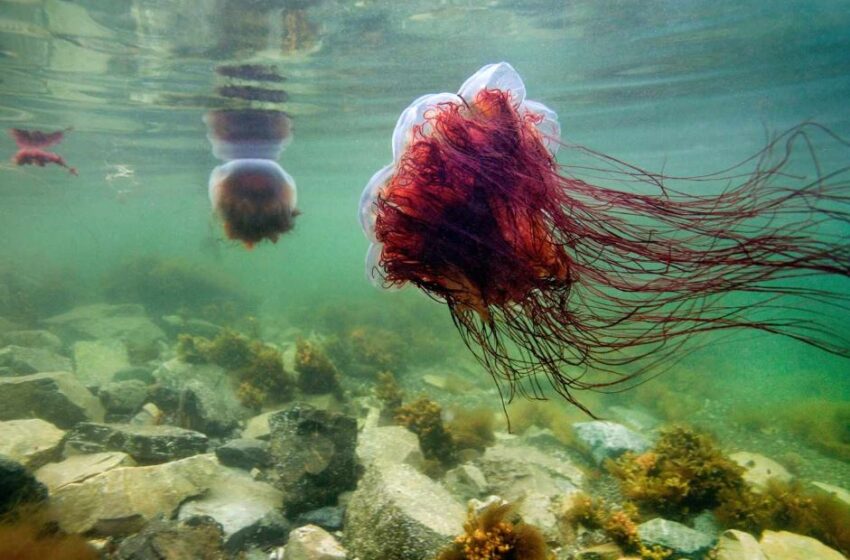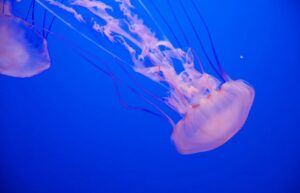Unveiling the Mysteries of the Lion’s Mane Jellyfish: Nature’s Majestic Underwater Giant

Physical Appearance
The Lion’s Mane Jellyfish (Cyanea capillata) is a huge and beautiful creature that is sure to impress. It is one of the largest known types of jellyfish. Its bell can be up to 8 feet across, and its tentacles can reach an amazing 120 feet. The jellyfish is called a “lion’s mane” because its long tentacles look like a lion’s mane. These tentacles can be red, orange, or even a very light purple.
Habitat and Range
The Lion’s Mane Jellyfish tend to live in the Arctic, North Atlantic, and North Pacific Oceans, where the water is cold. They are often found near the water’s top, where their symbiotic algae (zooxanthellae) can get enough light to make food. During the warmer months, they may come closer to shore, where beachgoers and boats can see them more easily.
Life Cycle of the Lion’s Mane Jellyfish
Reproduction
The Lion’s Mane Jellyfish starts its life cycle when males release sperm into the water, which fertilizes the eggs that females release. When these eggs are fertilized, they turn into planulae, which are larvae that finally settle on a solid surface and change into polyps.
Growth and Development
The polyps grow and make more of themselves without having sexual relations. This is called sprouting. When these buds fall off, they turn into ephyrae, which are the young jellyfish. The ephyrae grow into medusae, the adult form of the Lion’s Mane Jellyfish, which has a bell and long stalks that make it easy to recognize. The medusae keep getting bigger and bigger until they hit their full size, which takes about a year.

Diet and Predators
What Lion’s Mane Jellyfish Eat
Lion’s Head Jellyfish are carnivores that eat zooplankton, small fish, and even other jellyfish. Their long arms have special cells called cnidocytes that are filled with structures called nematocysts that can sting. When prey touches the stalks, these nematocysts release toxins that make the prey unable to move. This lets the jellyfish eat it.
Predators of Lion’s Mane Jellyfish
Even though they are poisonous, Lion’s Mane Jellyfish can still be eaten. Jellyfish are known to be eaten by sea turtles, especially the leatherback. Also, different kinds of birds and big fish, like sunfish, have been seen eating these giants of the sea.

The Sting of the Lion’s Mane Jellyfish
Venom and Its Effects
Even though the Lion’s Mane Jellyfish usually doesn’t kill people with its sting, it can cause pain, heat, and swelling at the site of the sting. In more serious cases, the person may have trouble breathing, cramps, or even heart failure. How bad the symptoms vary on how sensitive a person is to the venom, how big the jellyfish is, and how much contact they have with its tentacles.
Treatment for Lion’s Mane Jellyfish Stings
If you get stung by a Lion’s Mane Jellyfish, you should stay cool and go to the hospital right away. In the meantime, you can rinse the area with vinegar to help get rid of any tentacle pieces and dilute the poison. After you’ve rinsed the area, put it in hot water to help ease the pain. But it’s important to talk to a doctor or nurse to get the right medicine and advice.
Read more: Different Types of Sea Animals and Some Facts About Sea Life
The Lion’s Mane Jellyfish in Pop Culture and Research
Pop Culture References
Lion’s Head In the Sherlock Holmes story “The Adventure of the Lion’s Mane,” the jellyfish is a key part of the puzzle. Jellyfish are also a popular subject for photography and films because of how big and different they look.
Scientific Research and Findings
Scientists are interested in the Lion’s Mane Jellyfish not only because of its size and look, but also because it could be used to treat diseases. Studies have found that some compounds in the venom of jellyfish may protect neurons and reduce inflammation. These qualities could be used to treat diseases like Alzheimer’s and Parkinson’s.
Conclusion
The Lion’s Mane Jellyfish is a fascinating and strange creature because it is so big, looks so cool, and has a very strong sting. As we learn more about this huge sea creature, it becomes clear that there is still a lot to learn about the seas and the amazing creatures that live in them.
FAQs
-
How big can a Lion’s Mane Jellyfish get?
The Lion’s Mane Jellyfish can reach up to 8 feet in diameter, with tentacles extending up to 120 feet, making it one of the largest known jellyfish species.
-
Where can you find Lion’s Mane Jellyfish?
These jellyfish are found in the cold waters of the Arctic, North Atlantic, and North Pacific Oceans, often near the surface where their symbiotic algae can access sunlight.
-
What do Lion’s Mane Jellyfish eat?
Lion’s Mane Jellyfish primarily feed on zooplankton, small fish, and other jellyfish.
-
What predators do Lion’s Mane Jellyfish have?
Despite their venomous tentacles, Lion’s Mane Jellyfish have predators such as sea turtles (especially leatherbacks), various species of birds, and large fish like sunfish.
-
Can a Lion’s Mane Jellyfish sting be fatal to humans?
While the sting of a Lion’s Mane Jellyfish is not usually fatal to humans, it can cause a range of symptoms, from mild to severe. In rare cases, severe reactions may include difficulty breathing, muscle cramps, and heart failure.
Read more: Unique Sea Life Forms That Inhabit the Dark Depths







